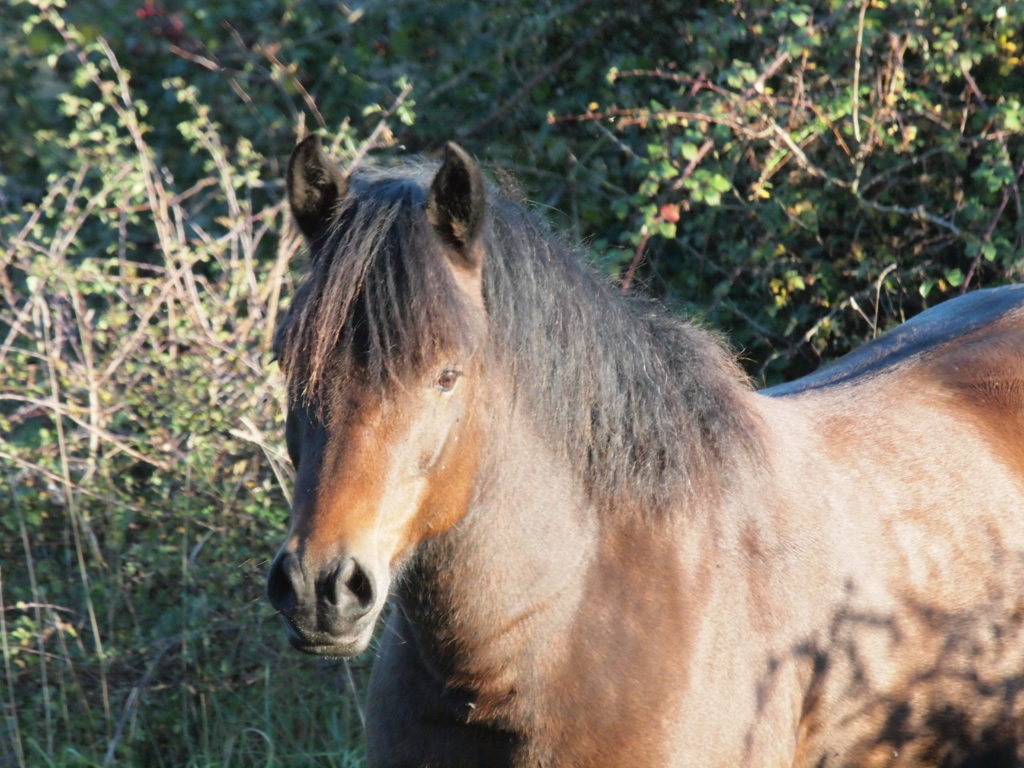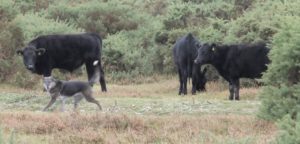
The law requires close control of dogs near livestock
The New Forest Commoners’ Defence Association (CDA) is advising commoners in the New Forest to dehorn their cattle. This unprecedented move comes after a series of serious injuries during 2018-19 involving walkers, mostly with dogs.
The Association’s chair, Tony Hockley, has written a letter to the 200 people who are registered to turn cattle out to graze the New Forest. Alongside the recommendation that cattle with horns are dehorned, Tony Hockley says that the CDA will be stepping up its campaign for better signage on appropriate behaviour around livestock, particularly the close control of dogs, and enforcement of law and byelaws related to this.
Mr Hockley commented:
“People seem to have lost all connection with the countryside and any healthy respect for large livestock. It is wonderful that the extensive grazed lowland heath has survived here, whilst it has been lost almost everywhere else. It is now a habitat that is more rare than rainforest, of global importance for biodiversity, Grazing by cattle is central to this. In the past the threat has come from development. Today it comes from thoughtless recreation. People seem genuinely unwilling to make even a small detour around livestock, and just to put their dog on a short lead around grazing animals. Yet the land is accessible to walkers because of the grazing.
“Over the years dangerous incidents involving livestock have been extremely rare. Yet, in the past two years there have been several. Commoning is a vocational activity. People choose to engage in it out of commitment to this special landscape, alongside their jobs. If someone is injured by a commoner’s grazing animal, it is deeply distressing for everyone involved.
“Poor behaviour by a few, makes potential victims of the many. One badly-controlled dog can make an animal defensive to other dogs, however well-c0ntrolled. We would urge people to inform the Police whenever they witness a dog out of control around livestock. It is illegal and reporting it helps protect everyone.
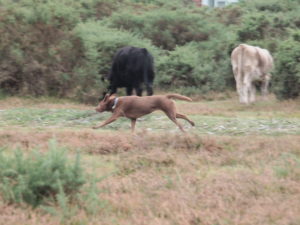 The CDA move on dehorning follows a packed meeting of cattle commoners on “Recreation and Cattle” held in September, hosted jointly by the New Forest Verderers and Commoners Defence Association. It was clear from this meeting that the general view was that something had to change, particularly the reintroduction of clear signage and enforcement of the New Forest byelaws.
The CDA move on dehorning follows a packed meeting of cattle commoners on “Recreation and Cattle” held in September, hosted jointly by the New Forest Verderers and Commoners Defence Association. It was clear from this meeting that the general view was that something had to change, particularly the reintroduction of clear signage and enforcement of the New Forest byelaws.
Tony Hockley explained the recommendation on horns:
“This was the one step that our Association felt we could take ourselves that might mitigate the harm done by the situation in which the New Forest now finds itself. Most cattle are already dehorned, which suggests that it is not something that would deter people from turning cattle out to graze. We decided to exclude British breeds for which horns are an essential characteristic, primarily English Longhorns and Highlands: As far as I am aware we have never had an incident involving these two breeds.
”Thus recommendation from the CDA does not override every commoners’ responsibility for decisions regarding their own animals, any risks to Forest users and the welfare of their cattle. Over time, however, we would hope that commoners will choose to use polled bulls in order to produce a herd that is free of horns, with maximum consideration for the welfare of our animals.
“We are also talking to government, the Verderers, and local agencies about other steps on education of Forest users and proper law enforcement”.
ENDS
CDA Chair, Tony Hockley, offers his personal views on the review of national landscapes
The review of Designated Landscapes led by Julian Glover faced a huge challenge: How to produce recommendations that would be appropriate across landscapes as diverse as Northumberland and the New Forest. Every designated landscape is unique and special. Thankfully, the final report is ambitious, but not prescriptive. If it is acted upon then it could create real opportunities for each landscape to do much better than today, without dictating how this is done.
There are some aspects that should have almost universal appeal. The demand for better and more secure funding for designated landscapes, and for efficient management, will be widely welcomed. Also, the demand that planning better protects these landscapes, whether in relation to development in the buffer zones around them, in upgrading the “regard” that public bodies must show these landscapes in their decisions, or in protecting and managing rights of way.
For the New Forest some things seem to leap out of the Glover Report. The demand for 1000 new rangers would be a dramatic boost. Whilst these would be unnecessary in some areas, they are desperately needed in the New Forest. Public ignorance and disinterest in its special qualities and in their fragility is diminishing it at a rapidly accelerating pace. Here the need to better connect people, particularly local people, to the landscape is urgent.
Our Heritage Lottery-funded Landscape Partnership has enabled the development of a brilliant Education Toolkit, that is now in schools, and this work could be scaled up to have a significant impact on appreciation of this incredible and rare lowland landscape. The Partnership also backs an Apprentice Ranger scheme, in which young commoners have participated, but with no career path at the end, and has backed social media and conflict resolution training for commoners. Every day the 700 New Forest commoners are engaging with the public, whilst they are out looking after their animals. But commoners have jobs too, and cannot be there as informal rangers when they are most needed. The Glover proposals could transform this situation if they are delivered. Our handful of employed rangers, and the volunteer rangers, do a fantastic job, but they are far too few in number to have much impact in such a busy landscape that is increasingly used and abused around the clock, 365 days of the year; National and local countryside laws are largely unknown and completely unenforced, with inevitable consequences. A professional group of rangers, with real recognition (as in the US) and a real career path, could make a substantial difference. It would, of course, provide a new career opportunity for commoners, that keeps some of the people who know the New Forest best within the New Forest. Alongside environmental management this provides good quality work to offset the decline in forestry employment.
Living in Landscapes
The other vital content in the report for the New Forest, relates to the economic and social pressures on the vocational commoning system upon which the landscape has always depended. Housing costs in Britain’s least affordable national park, along with few local career opportunities with decent rates of pay, and very poor public transport are driving away the young people who would continue to keep and graze livestock here if it was economically possible. For some this will be the end of a tradition stretching back generations. Whenever this happens the cultural heritage of the New 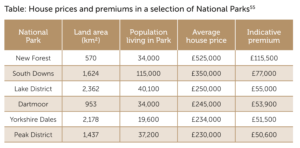 Forest suffers another loss. The proposal for a National Landscapes Affordable Housing Association could prove valuable. The report refers to the recent New Forest National Park Authority initiative to develop and rent two affordable homes at Bransgore. There are, of course, also around 65 Crown properties currently managed by Forestry England on behalf of the state. It may be more appropriate, transparent and sustainable for these to be managed by the new Housing Association focused on the local needs of the New Forest. The report also suggests that, outside of the CAP, the concept of “public money for public goods” in new Environmental Land Management Schemes (ELMS) might extend support to housing.
Forest suffers another loss. The proposal for a National Landscapes Affordable Housing Association could prove valuable. The report refers to the recent New Forest National Park Authority initiative to develop and rent two affordable homes at Bransgore. There are, of course, also around 65 Crown properties currently managed by Forestry England on behalf of the state. It may be more appropriate, transparent and sustainable for these to be managed by the new Housing Association focused on the local needs of the New Forest. The report also suggests that, outside of the CAP, the concept of “public money for public goods” in new Environmental Land Management Schemes (ELMS) might extend support to housing.
To some it may seem an esoteric point that the report suggests amending the statutory purposes of the national park authorities, but the new emphasis on “recovering” nature rather than merely “conserving” what has survived, on vibrant local communities, and on education is important. In a world of constrained public sector resources anything that is not a statutory purpose is easily neglected. The proposal for a new National Landscapes Service, effectively a regulator of our protected landscapes, could also ensure that national park authorities are directly held to account for delivering on their statutory purposes. This would be a significant improvement on the level of attention usually devoted to them by DEFRA.
Landscapes for Everyone
The report draws attention to a serious lack of connection between the population and the countryside, and the domination of white, middle-class “club”. On the one hand there is a large part of society for whom the countryside seems off-limits or has no appeal, and another for whom it is somewhere they can simply do as they please. This divide has certainly not served the New Forest well: Anyone who tries to promote appropriate behaviour has the word “park” thrown back at them, if not worse. Indeed, many of the things that people think acceptable in the New Forest would not be acceptable in a park, particularly in relation to dog control or encroachments on the common land. Glover rightly rejects that idea of introducing charging to tackle visitor pressures. Not only would this detract from the ambition to connect more people to the countryside, but would also enhance the “anything goes” entitlement mentality of those who pay to use it.
The New Forest Education Toolkit is certainly a step in the right direction, but this incredible landscape needs to be shared with far more children beyond the New Forest National Park boundary. The report proposes that every child should be entitled to an educational “night under the stars”. We could embrace this mission to connect the next generation to the countryside by repurposing the campsites on the Open Forest. These sites, located on SSSI land, are currently a real cause of concern, for the direct harm they do to the habitats and dangerous behaviour around the grazing livestock. If they are to be retained on the Open Forest, rather than moved to enclosed land, then the “Night under the Stars” initiative could well provide a route to putting them to a social purpose instead of pure income generation. An educational use could be a win-win for the New Forest and for society. Commoners could play a central role in sharing the wonder of the New Forest and the grazing animals.
Glover emphasises a need to better signify these special landscapes, particularly where multiple land managers tend to use individual and incoherent signage . “They should look and feel special” the report says. This lends weight to the new partnership project in the New Forest to make it “Special by Design”, so that the landscape becomes visually unified, whilst each land manager retains their own identity. Anyone entering the New Forest should know that they are entering somewhere very special every time they cross a cattle grid.
In conclusion, the ball is now in the Government’s court. It is unfortunate that the Secretary of State who set up the review has now moved on, and highly likely that further change is imminent. Those who care for the countryside will need to keep up the momentum.
Tony Hockley
September 2019
Recreation & Cattle
7.30pm, 19th September 2019, Lyndhurst Community Centre
All cattle commoners are invited to a special meeting hosted jointly by the Official Verderer and CDA Chair to discuss issues relating to recreational pressures and grazing cattle.
If you have cattle marked to graze the New Forest you should also have received full notification of the meeting from the Verderers, by post or email.
Refreshments will be served from 7pm.
Please note that this meeting is for active cattle commoners only
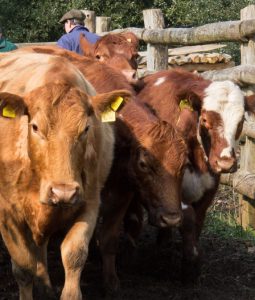
© 2018 Sally Fear
In May 2019 the CDA wrote to Michael Gove alerting him to Forestry England’s new and unauthorised approach to marketing Crown-owned land and homes in the New Forest. After a long delay DEFRA ministers agreed in July that the failure to consult on this dramatic change was “unfortunate” and demanded that Forestry England conduct a formal consultation if it wanted to change direction. The minister, David Rutley MP, also demanded that this consultation must be completed by the end of 2019, when a “shared outcome” should be presented to ministers.
The CDA is really grateful to our local MPs*, who all pressed ministers to force Forestry England to come clean on their plans for the Crown holdings, after three years of stealthy change.
We were disappointed that in the meantime the Forestry England Land Agent for this area, used the Verderers Court to sow confusion. Once again he tried to pretend that nothing had changed – that those who do essential work in the New Forest would continue to be supported. In truth his rent hikes are making the properties unaffordable to the real hands-on workers of the Forest, going instead to the highest bidders at hugely inflated rents. The advertised rents would be more than 100% of land-workers’ annual salary. This obfuscation is, however, unsurprising from someone who has made it clear repeatedly that his sole task is to extract maximum revenue from the landscape.
The minister’s intervention now means that a series of consultation meetings will be held. This Review Group will meet on 2nd September, 14th October and 25th November, and will be chaired by the chairman of the National Park Authority. Both the CDA and the New Forest Verderers will be represented in the Review Group. Given the exploitative approach now being taken by Forestry England we know that this will not be straightforward, unlike the process of the Illingworth Report in the early 1990s when all involved were focused on benefit to the New Forest landscape. Our representatives in the consultation will, of course, be working hard to make the case that these properties have been saved from past Forestry sell-offs because of their value to the New Forest, and that the case for using them as affordable bases for commoning into the future has only got stronger over recent decades.
* John Glen MP, Rt Hon Dr Julian Lewis MP, Rt Hon Caroline Nokes MP, Rt Hon Sir Desmond Swayne TD MP
Forestry England “celebrates” its centenary this year. It will be much less of a celebration amongst those who care for the New Forest. Austerity has seen significant real cuts to Forestry England’s budget in recent years, although it still receives some £45 million of taxpayers’ money to carry out its core work. The New Forest is paying a heavy price as Forestry England seeks to maximise revenue and minimise its costs. Far from putting the Forest first it is turning back the clock to its original purpose of profit instead of protection.
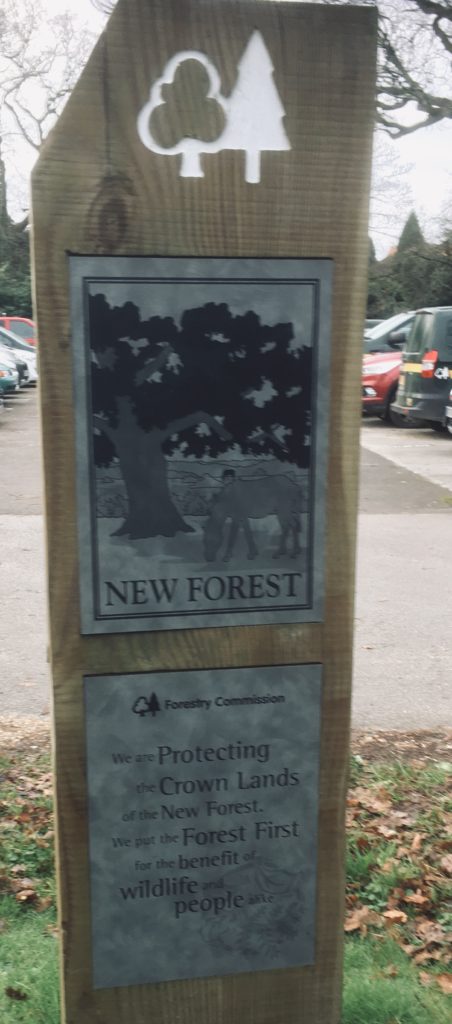 The origins of Forestry England lie in the devastating exploitation of the New Forest. But around the start of the 21st century it came to appreciate the fragility of the landscape and the commoning system upon which it depends. Its own Land Agent produced the “Illingworth Report” for the government in 1991, seeking ways to sustain the grazing of the New Forest, and upon which everything else depends. But now it appears to be returning to its exploitative, uncaring roots. It is becoming a typical large-scale landlord: Distant, disinterested, and non-communicative. Anyone who has tried to contact Forestry England outside of office hours will know full well the low level of attention.
The origins of Forestry England lie in the devastating exploitation of the New Forest. But around the start of the 21st century it came to appreciate the fragility of the landscape and the commoning system upon which it depends. Its own Land Agent produced the “Illingworth Report” for the government in 1991, seeking ways to sustain the grazing of the New Forest, and upon which everything else depends. But now it appears to be returning to its exploitative, uncaring roots. It is becoming a typical large-scale landlord: Distant, disinterested, and non-communicative. Anyone who has tried to contact Forestry England outside of office hours will know full well the low level of attention.
Forestry England appears to have reversed the three objectives set out in the Minister’s Mandate for its management of the Crown lands. The primary objective of conservation is now subservient to the third objective of income generation and efficient management. In the Ministers Mandate it is made explicit that Forestry England’s commercial interest must only be pursued where it is consistent with conservation: “Forest First” is the official mantra. In truth, the book-keepers of Forestry England’s Bristol HQ are now the priority, not this precious landscape which they are paid by taxpayers to conserve.
The most blatant example of the new commercial agenda has been in the total disregard for government policy on the management of Crown properties within the Forest. For generations these have provided the bedrock of commoning: The Commission providing employment, and smallholdings for rent, for commoners. As commercial forestry declines the policy requires that these are prioritised to continue to support commoning, made available to commoners (whether Commission employees or not) at affordable rents. In October 2017 ministers reminded Forestry England that policies can only change if ministers decide to do this. This has been ignored completely. Instead it has continued to move all properties to unaffordable market rents, approaching £2000 a month, and prioritising their use as a perk for its own employees. It is setting rents that are at least 70% of average local household incomes, and more than 100% of most young commoners’ incomes. This is no different to a local authority deciding to hand social housing to its managers. In just three months at the end of 2018 the keys for three commoners’ holding were handed to Commission staff, none of whom were commoners. Others are standing empty, but the desire to maximise revenues gives little hope of any being used to support the continuation of commoning.
In 2006 DEFRA ministers stated that the proportion of cottages rented to commoners would increase. It is now in rapid decline. In the past three months alone three excellent commoners’ holdings have been handed to Forestry England employees, who have been told that they will go on the open market if not taken up at rents of £18-24,000 a year. It is now advertising a cottage for £1450 a month for commoners with a minimum of 10 ponies, yet providing little more than one acre of back-up. The criteria are as arbitrary as the rent. It is designed to fail so they can take it onto the holiday homes market. The CDA have been discussing these concerns with Forestry England for three years, but they have ploughed on with the new strategy regardless. It is hard to overstate the damage being done to the sustainability of the New Forest landscape by the loss of these prime commoning holdings. The cottages were retained in these locations for a purpose, but one by one commoners are being forced out of the Forest and the direct contribution of these properties to the local Forest is being lost. Forestry England argues that extreme property values in the New Forest mean that affordable rents are nothing more than an intolerable “opportunity cost” for its Bristol book-keepers, that anything below open market rents is an unaffordable subsidy. For commoners who subsidise their livestock through their own time and income, and whose taxes fund Forestry England, these claims add insult to injury.
The unilateral abandonment of a “Forest First” strategy is also visible in the increasingly aggressive management of its campsites in the New Forest. According to recent Annual Reports for Camping in the Forest LLP, the “key strategic focus” for this new joint venture for the campsites on the Open Forest SSSI is to “grow pitch nights”, against which the protected status of this land is described as the “principle risk” facing the business.
In 2019 Forestry England celebrates its centenary, with its latest rebranding from Forestry Commission. It seems that it is also reverting to its original 1919 mission, to simply maximise its exploitation of the landscape. The New Forest seems to be little more than a local irritation, that requires financial support, diverting the agency from its relentless pursuit of revenues. In 2011 the country thought it had fought off forest privatisation. It now seems that the same outcome is being achieved under the radar. No-one within the Forestry Commission seems able to act as a voice for the New Forest, and the Minister’s Mandate is simply withering on the vine.
Commoners have fought off similar threats over centuries. We have no intention of standing by and letting them happen today.
10 FACTS ABOUT THE CROWN HOLDINGS IN THE NEW FOREST
- There are around 65 Crown properties in the New Forest, originally built for forestry, and now managed by Forestry England on behalf of the Department of the Environment, Food and Rural Affairs
- In the late 1980s a thorough New Forest review for Government concluded that the best way to maintain the New Forest landscape was to support the vocational system of small-scale commoning. The Illingworth Report set a policy, endorsed by ministers, that forestry properties in the New Forest would be retained to provide bases for commoning and rented to them at 15% of income given the local disparity between incomes and rents.
- This policy was repeated in 2006, when DEFRA minister, Ben Bradshaw, said that the cottages had been retained for commoning, and that an increasing proportion would be allocated to commoners as Forestry operational needs decline
- In 2016 Forestry England unilaterally declared a policy to move land and holdings towards market rents for all tenants
- In October 2017 DEFRA minister Dr Therese Coffey responded to a question from Desmond Swayne MP (New Forest West) confirming that any change from the Illingworth policy would require full consultation and a proposal put to ministers for approval
- In July 2018 the Assistant Land Agent emailed all local Forestry England staff offering currently vacant cottages at rents between £18000 and £24,000 per annum, regardless of local operational need, and with no preference for staff who would graze livestock from the holdings. The email stated that any holdings left would then be let on the “open market”, with no mention of commoning. This email was leaked to us.
- In May 2019, under pressure from the CDA, Forestry England decided to offer one smallholding to commoners, by a tender process with an advertised price of £18,000 a year. They imposed a requirement to graze 10 ponies, despite the holding having just 1 acre of back-up land and three pony stables, grossly insufficient for the care of 10 animals. They also chose to separate the barn from the property in order seek a commercial tenant, leaving the holding with no facility for the storage of hay or equipment.
- For three years the CDA has sought to discuss this matter with Forestry England and been willing to update the Illingworth policies to reflect changes in the housing market. Forestry England have simply continued to implement its open market and market rent policies
- The average local property value in the New Forest has now reached a multiple of 15.9 times average local income. The national park premium for a property within the New Forest is now £300,000. It is Britain’s least affordable national park
- In May 2019 the New Forest Trust charity obtained planning permission for one small rental holding, which will be built after a local fundraising campaign, and which is already heavily oversubscribed by young commoners in need of an affordable base within the New Forest.
Stallions, geldings and mares
Why do some commoners run geldings on the New Forest, and how might this affect the stallions and mares?
By Jenny Tillyer
Common Rights of Pasture do include the right to run geldings on the forest at any and all times of the year. There are various reasons that a commoner might run geldings and it is entirely up to each individual, but I suggest a few of the scenarios are:
running young geldings on until they are old enough to be broken in etc. This provides a really excellent life education and experience for the young boys. However, a down side may be that the youngsters often don’t grow on as well (add as much height) due to the restricted amount of food.
- turning out a riding gelding due to temporary lack of rider etc.
- turning out a riding gelding that has been injured and requires a long time off work, or is retired.
- a ‘pet’ that the owner simply does not want to part with.
- geldings running on the forest also allows a person to be a ‘commoner’ without any of the hassle of having a mare that has a foal.
Some of the problems from geldings arise when it comes to the breeding season. The gelding has probably lived with his herd of mares all year and may become rather upset when a stallion suddenly appears and tries to relocate the mares into his own harem. If the gelding is a mature adult he may have more weight and height than maybe a younger, inexperienced stallion and this can easily result in the stallion being driven away to try his luck in a different area. Or the stallion has to put up a real fight, with the risk of injury, to establish himself as the top horse. Bearing in mind that the stallions are only out on the forest for approx 5 weeks these days, it is important that he can ‘settle down’ and get on with his job as quickly as possible rather than having to fight his way in to start with – the poor stallion gets enough grief from the mares; he really doesn’t need any trouble from anywhere else.
A gelding may live happily with a bunch of mares and, especially if a stallion is not directly in the area, appear to cause absolutely no problem. But the fact that the gelding is there may reduce the chances of the mares travelling to find the stallion – although some of the really determined mares still seem to manage to sneak off and get in foal.
Having a gelding on the forest that runs with a bunch of mares does not really give any ‘structure’ to the herd – this is done by the older mares or the stallion – but if, as an owner, you don’t want your mares to get in foal then the fact that they run with a gelding may be a good thing.
But, overall there are more commoners that ‘need’ foals (well, the fillies, as replacements – they are in desperately short supply) and the more chances that a stallion has to get the mares in foal, the better; so the least amount of interference from geldings to reduce the stallion’s ability to do his job, would surely only be a desirable thing.
For more of Jenny’s blogs follow her on Facebook: https://www.facebook.com/commonerslife/
By Tony Hockley
Chair, New Forest Commoners Defence Association
#DiscoverNationalParks fortnight 2019
As the country celebrates the 70th anniversary of its national parks it is important that we also stop and think about their next 70 years. Recent forecasts of New Forest visitor pressures have once again rung alarm bells that recreational use of this protected landscape is unsustainable (the majority of it is designated as a Site of Special Scientific Interest, Special Protection Area, etc.). As the charts and tables from these forecasts show, visits by Forest users are expected to continue rising; from an estimated 15 million in 2017 to more than 17 million by 2037.
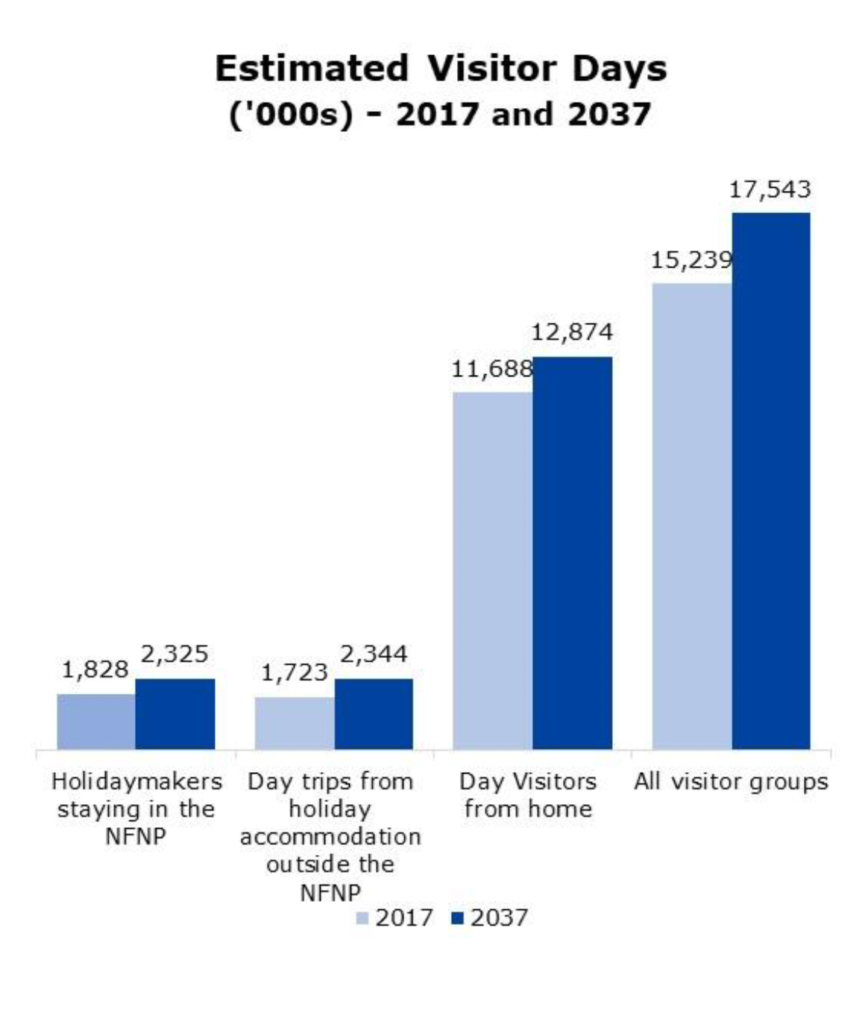
RJS Associates (2018)
Numbers alone tell only part of the story. Access to the landscape is not the main threat. The real threat lies in rapidly changing user expectations and user behaviour. There is much discussion nowadays of the need for “experiences”. For many this means thrills and selfies. The value of quiet enjoyment and connection to nature is being lost. In a recent “rewilding” event hosted by the Friends of the New Forest, there seemed to be general agreement that we must first “rewild people”, re-connecting them with the countryside and nature, its value and its fragility. Whether the problem is out of control dogs or direct interference with livestock many people simply do not appreciate the harm that they do, or the consequences of their actions. We all think that our own dog is “different” or that, as regular users ,we know better or cause less harm than “others”. In truth all of our actions matter in a protected landscape; for their own impact and as a signal to other people of what is normal and acceptable behaviour. Our actions shape the behaviour of grazing animals: An animal’s single experience with a troublesome dog is likely to engender a defensive response to every other well-behaved dog that walks nearby thereafter (Some of these behavioural issues are excellently explored in a Hampshire Countryside Service advice document on dog walking aimed at land managers).
The New Forest is an incredible landscape. This is not just for the absence of fences and other barriers, but as home to a huge range of rare species. Some of these are almost extinct in Britain, where they were commonplace within our own lifetimes. Restoring the “wow factor” of appreciation for the grazed landscape and all it supports will be vital to dealing with rising user numbers.
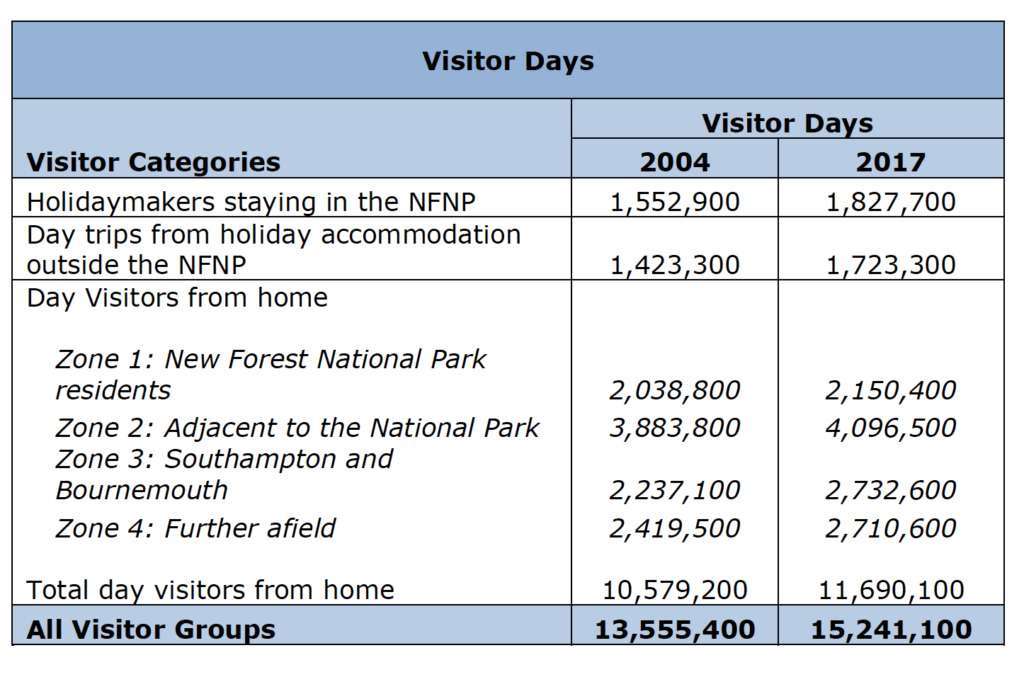
RJS Associates (2018)
“It is time to push back against familiarity with Britain’s most accessible National Park”
This should not be an impossible task. Most of the user pressure comes from regular users living within minutes of the National Park boundary, if not within the boundary. For three-quarters of the year day “visits” from home outnumber those by staying “tourists”, with dog-walking the most common purpose.
We must all help share with our neighbours our appreciation of everything that is wonderful about the New Forest. We must push back against the disregard, or even contempt, that can come from familiarity. It is time to push back against familiarity with Britain’s most accessible National Park. From its smallest 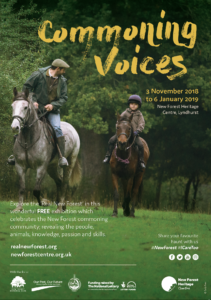 bugs and tiniest plants to its largest beasts and ancient wood pasture the New Forest is as incredible as any National Park in the world. `It has survived to the 21st century by the equally-incredible survival of a vocational system of commoning by local households.
bugs and tiniest plants to its largest beasts and ancient wood pasture the New Forest is as incredible as any National Park in the world. `It has survived to the 21st century by the equally-incredible survival of a vocational system of commoning by local households.
It is in this push-back against over-familiarity that National Park status is beginning to make the biggest difference. It is unlikely without this status, for example, that the current Lottery-backed £4.4million Landscape Partnership would have been possible. This is building understanding of the New Forest amongst the next generation of children in local schools, engaging people in volunteering opportunities, and enabling the “Commoning Voices” exhibition to tour venues around the area. it has also enabled the Commoners Defence Association to build dedicated sections of its website for the task of sharing understanding of the special qualities of the New Forest and explaining actions that each of us can take to better enjoy and care for it.
“Huge personal and social benefits would come from improving the diversity of those who enjoy the countryside”
As commoners we want everyone to love the New Forest as much as we do. We also recognise the huge personal and social benefits that would come from improving the diversity of those who enjoy the countryside. Our hope is that by opening to new social groups of people their sense of wonder for this extraordinary lowland landscape will infect those who benefit from it day-in and day-out as just doorstep green space. We should warmly welcome people who enjoy the Forest for all of its special qualities, with their eyes wide open to its wonders. But it is not a petting zoo or playground. It is very special and very fragile, and all the more enjoyable because of this. Indeed, those of us who were not brought up in the New Forest will recall our first experiences, as a magical constrast to our boxed-in urban lives.
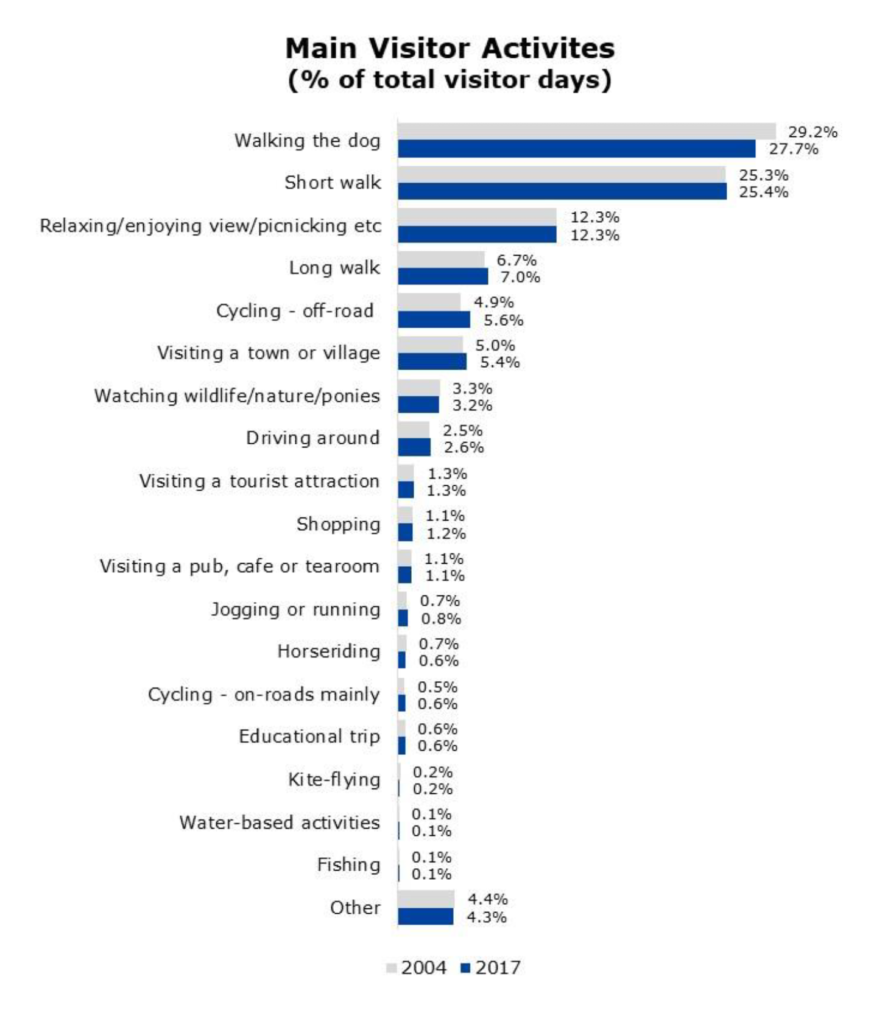
RJS Associates (2018)
The challenge from the latest user forecasts is to work together to overcome indifference to this landscape. No-one should be indifferent to such an extraordinary place, kept open and freely accessible to all due to its survival as common grazing in one of the most populated and developed areas of Britain. Three-quarters of lowland health has been lost since 1800, and much of this in the past 100 years. This is now one of the most important, most rare, and most biodiverse landscapes in the world. Visitor numbers are of much less relevance if , working together, we can turn the tide of indifference.
Good intentions, however, will only take us so far in turning this tide. Two important steps are urgently required:
National Park Rangers.
Firstly, the New Forest has a ridiculously small number of rangers trained to engage with Forest users. At present that have no powers to police either the byelaws or criminal law. The byelaws that were designed by our predecessors to protect the New Forest are now simply ignored, particularly on the parts of the New Forest in state ownership. In the recent past Forestry Commission keepers had the status of special constables; but as keepers have withdrawn from engagement work and their numbers cut, nothing has filled the gap. This is in stark contrast to the active protection and engagement seen in other national parks around the World.
Clear Identity & Purpose
Secondly, it must be clear to anyone accessing the New Forest, by whatever means and however often, that we are privileged to be in a very special place. No-one would want the New Forest covered with signs, but if there is no indication of the special status of the landscape and no communication of the priority attached to appropriate use, then it is easy to understand why problems arise day after day. The New Forest has many landlords (but the largest area is state-owned) and no consistent identity as a protected landscape. Whilst each landowner will rightly wish to push their own brand the lack of an overarching brand and a consistent, simple message of protection is now an omission that has to be addressed.
This weekend marks the start of Discover National Parks fortnight: Whilst there are still too many people who have not yet discovered these extraordinary landscapes and their stories, for the New Forest its most regular users need to re-discover them and re-discover the sense of wonder. There is no point chasing visitor numbers, if in achieving this we simply destroy the reasons for designation as a national park. 17 million users determined to protect and enjoy a National Park, would have a totally different effect on its survival than 17 million determined to simply exploit it. It certainly ain’t what you do, it’s the way that you do it.
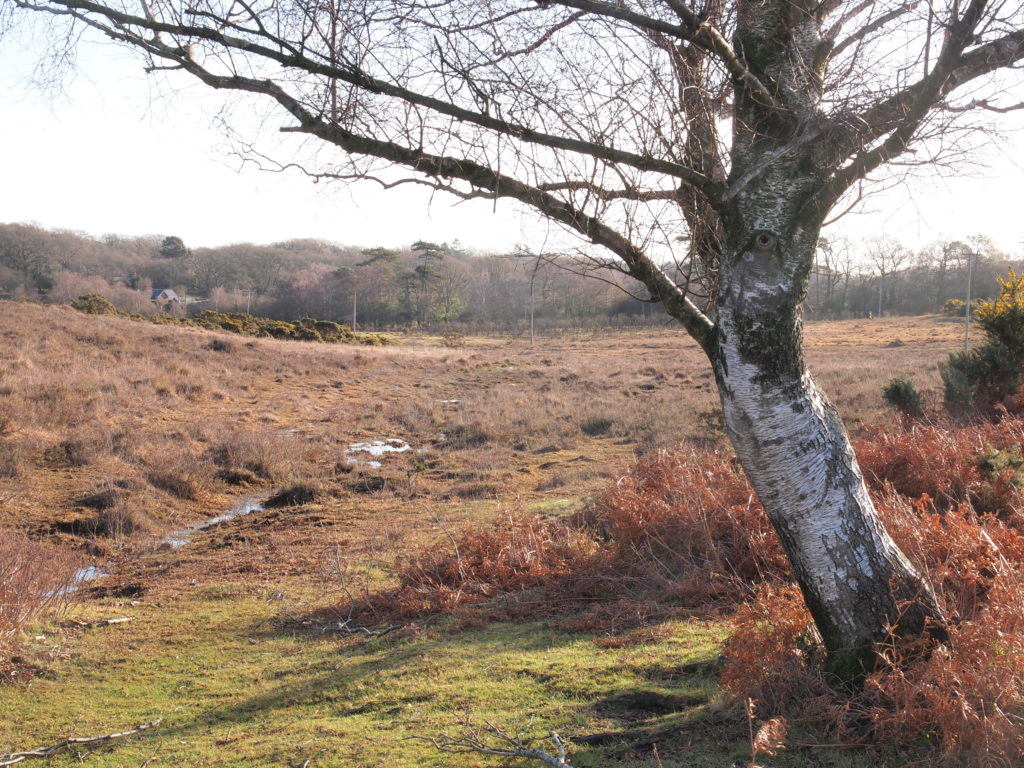
by Jenny Tillyer, New Forest commoner, February 2019
Burning on the Forest: Controlled and Wildfire
The traditional burning season is just getting underway and I wanted to highlight the massive difference between the controlled burns that are carried out at this time of year, as opposed to the wildfires that are often started accidentally (or deliberate arson) but almost always happen at a time when a huge amount of damage can be caused.
Gorse and heather needs to be controlled to keep it healthy and flourishing – when it gets too old and tall it becomes far less ‘useful’ and deteriorates into a barren habitat – and an increased fire risk in a dry summer.
There are some areas that are mowed instead of being burned but this is done to complement the burning, not replace it. The problem with mowing is that it can put a mulch on the ground, which enriches the soil and this is undesirable in the Forest. Burning ‘cleans’ the ground of general debris and rubbish and can actually help with germination of dormant seed – but burning cannot be carried out under power lines for instance.The areas to be cut and burnt each year are selected (often from commoners suggestions) inspected and approved by a number of organisations during the summer. Then, in autumn or early winter, the ‘traces’ are mowed out. These are to define the area to be burnt by providing a fire break of very short herbage so that the fire naturally dies/can be stopped from spreading out of control.For the actual process of burning, there are all sorts of factors to be taken into account:-
- The wind direction and strength are obviously major considerations.
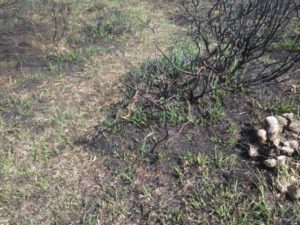
1. Three Weeks after a Controlled Burn
- The levels of wet and dry – the ground needs to be damp/wet but the herbage/foliage needs to be dry.
- The burning teams of skilled, trained and experienced people need to be available.
- The correct equipment – particularly a water bowser – needs to be present at the site.
The fire brigade has to be notified with the precise location – sometimes they choose to attend as part of their training and experience in dealing with scrubland/heath fires.
Notices have to be put out to inform the public of a controlled burn.
Areas burnt at one time tend to be quite small (a few acres) but, especially when the areas are slightly larger, the site has to be checked over to make sure that no livestock are present.
The burning is usually done into the wind (this is known as back burning) rather than with the wind. This enables the fire to burn a little bit slower, hence more thoroughly, and makes it easier to control.
The forest wildlife needs a patchwork mosaic of different heights, ages and densities of vegetation for the best biodiversity. The relatively small, controlled burn, areas are quickly recolonised from all sides.
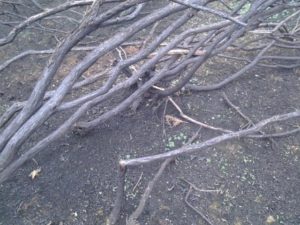
2. Six Months after a Wildfire
So, let’s compare the controlled burning to the wildfires. I would describe the difference between the two as a controlled ‘cold’ burn and a ‘hot’ wildfire. The controlled cold burn is done at the correct time of the year, when the ground is sufficiently damp so that the soil/peat/top layer does not get burnt. The wildfire hot burn frequently occurs during the dry summer and so the fire damages the top soil layer (and occasionally even deeper)
- Controlled burning is done while many/most species are dormant. Wildfire often happens during the active breeding/feeding young etc season.
- Controlled burning is done in smaller, inspected and approved areas. Wildfire can burn some very large areas which could be of special importance.
- Controlled burns are carried out by experienced people at suitable times to take into consideration the safety factors involved. Wildfire is an emergency that the Fire Brigade has to deal with and possibly puts a lot of people’s safety at risk.
Controlled burn areas provide another nutrient/food source for the livestock at a time of year when it is extremely beneficial. Wildfire often burns too completely (due to the higher heat) to leave much that is of any benefit.
The 2 pictures above show the different results from a controlled burn and a wildfire. Picture 1 was taken approximately three weeks after a controlled burn. Picture 2 was taken approximately six months after a wildfire.
This post first appeared on Jenny’s Facebook page “A Commoners Life in the New Forest”
by Tony Hockley, New Forest Commoners Defence Association
“You are amazing. We bow down to you. We are trying to emulate what you are doing!”
In his opening words to a Lyndhurst meeting organised by the Friends of the New Forest the leading light of the British rewilding movement, Charlie Burrell, paid homage to the New Forest as a unique survivor of Britain’s ancient wild landscape. The owner of the now famous Knepp Estate in West Sussex revealed a quite surprising lack of knowledge of the New Forest, given the proximity of Knepp. Indeed, he was surprised to discover how close the Forest was to Southampton. Perhaps this is part of the natural tendency in Britain to look abroad for inspiration, and ignore the everyday extraordinary landscapes on your doorstep. Perhaps this is part of the New Forest’s problems, that its special qualities are so easily overlooked. This was a point made later in the meeting by Diana Westerhoff, Natural England’s appointee to the New Forest Court of Verderers: Much of what is so special and so rare in the New Forest can be hard to spot for the untrained eye, citing the examples of the multiple lichens that need hard-grazed lawns to survive.
Rewilding at scale
To Charlie Burrell the scale of the New Forest free of fencing presents a vision of what could be achieved if experiments such as Knepp could be replicated on a larger scale, allowing the large herbivores to roam at will. Even the New Forest is a minnow in comparison to the truly wild landscapes of places like Yellowstone in the US. He explained the balance between scale and management intervention, so that the degree of active management required can decline as scale rises. Although 114km of internal fences have been removed at Knepp, so that the estate now has just three “blocks” of former agricultural land, each of the three is managed differently, with grazing by pigs, ponies, cattle, and deer. Rewilding he said is “process led”, with no defined end-game, but seeing where nature leads. The estate now has about 700 deer grazing, including red deer which found their way there rather be introduced with the smaller species, given the initial concern that an injury to someone using a footpath could threaten the project. The deer, he said, are essential “fight back” against the vegetation, “to ring bark trees” and help maintain the open landscape.
The desire to introduce wild boar to Knepp was prevented by legislation of dangerous wild animals, but this did not stop Charlie Burrell wondering aloud whether bison might help the New Forest educate the public on behaviour in an open access landscape. Perhaps, one day they could be introduced on rewilded land adjacent to the New Forest, and maybe one day the fences would come down, so that the bison could start to change attitudes to wild landscapes and “rewild us”.
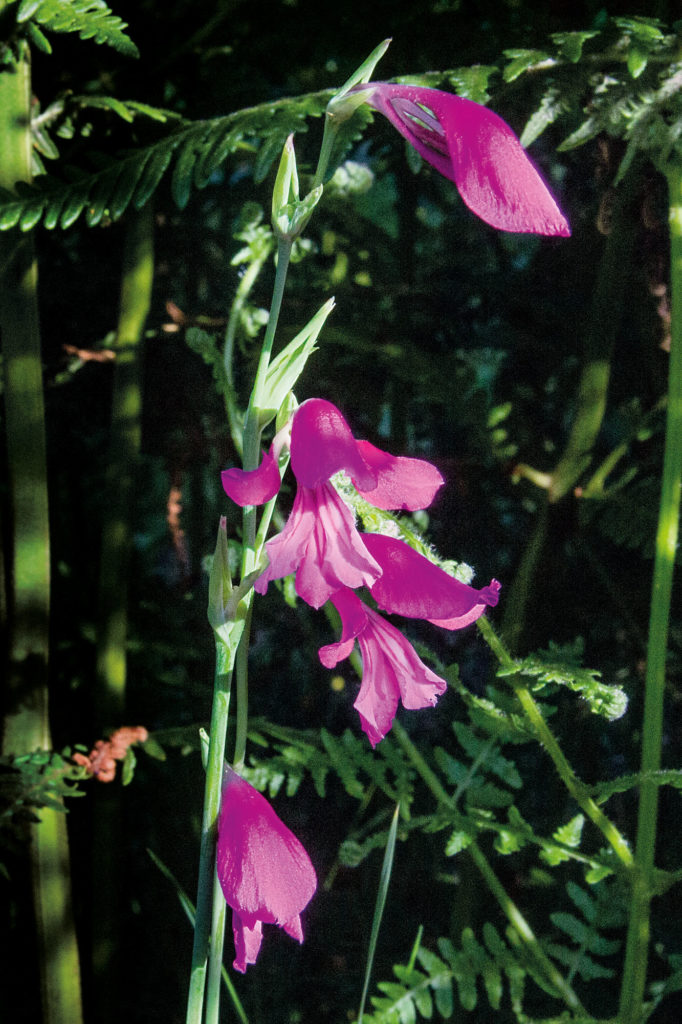
© Sally Fear
Much of the questioning put Diana Westerhoff, in the hot seat, as a proxy representative for Natural England. She explained the current conflict between the Rural Payments Agency (RPA) which excludes gorse from the New Forest’s “eligible area” for support under the EU Basic Payments Scheme, and Natural England’s recognition of gorse as a vital habitat as part of the grazed New Forest. Additionally, poor funding for Natural England means that it can do much less monitoring than desired in this protected landscape. Charlie Burrell commented that, despite the appearance of an RPA takeover of Natural England the appointment of Tony Juniper as the chair of Natural England means “there is hope”.
Our moment in time
Much of the questioning related to claims of “overgrazing”, including a lack of tree regrowth in pasture woodland, and suggestions that nature was in decline in the New Forest (One questioner was also under the false impression that ivermectin wormers are used in Forest livestock). Diana Westerhoff directly addressed these beliefs emphasising the multiplicity of competing species, many only visible to the expert eye,whereas Charlie Burrell pressed the need to take a long view for wild landscapes, where grazing pressures rise and fall over time. This is, he argued, “Just a moment in time. It doesn’t matter”. Movement and change, he said, takes place over a very long time.
Rewilding People
Perhaps the topic of greatest consensus was education. Charlie Burrell told of young farmers visiting Knepp who were unable to identify common trees and Debbie Tann from the Hampshire and Isle of Wight Wildlife Trust pressed a case for “rewilding people”. This is, she said, made harder by plans for excessive housing development around a protected landscape and widespread misinterpretation of the word “park” in “National Park”. Charlie Burrell noted that the greatest problem from visitors stems from dog walking, particularly with regard to ground-nesting birds.
Inspiration for the Future New Forest
What messages did the discussion carry for commoning? It certainly emphasised the value of redoubling efforts started under the New Forest’s current “Our Past Our Future” (OPOF) landscape partnership, funded by the National Lottery Heritage Fund. Not only is an Education Toolkit, bespoke for the New Forest, now being introduced to the curriculum in local schools, but the CDA’s Shared Forest project is finding new ways to engage with local people and businesses, and to share messages about valuing and protecting this very special landscape.
It also emphasised a need not only for enhanced monitoring of New Forest biodiversity, but also much better communication of what is already being achieved. Other OPOF partners are doing fabulous work on improving and monitoring biodiversity; not least the Freshwater Habitats Trust whose research is revealing not only the extraordinary cleanliness of ponds and streams in this traditionally grazed landscape but also the success of some of the little-known but exceptionally rare species that survive here but are all but wiped out elsewhere. There are also wonderful data coming from organisations such as Buglife and Plantlife, that need to be shared more widely. Monitoring of wetland restorations taking place under the Verderers’ Higher Level Stewardship (HLS) scheme are also now in the monitoring phase and evidence from these should be very useful as a guide to future management.
As these projects draw to a close the rewilding discussion has certainly hinted at some interesting initiatives that could be supported by a future Lottery bid and by whatever agri-environment scheme replaces the EU Basic Payments Scheme and HLS; better protecting some of the most tranquil and fragile habitats and species, experimenting with a variety of management regimes across the Forest’s amazing mosaic of habitats, and in the substantial enclosed lands of the New Forest (including commoners’ back-up grazing). The CDA has, of course, been working closely with its local and national partners to ensure that future support is best able to benefit the New Forest for future generations to appreciate and enjoy. This is certainly an exciting prospect in what Michael Gove described as an “unfrozen moment”.
This was all wonderful food for thought. Meanwhile we press on with “rewilding us”.

New Forest 27th January 2019
There can be few things more demotivating than seeing daily vocational effort for a cause you love under attack from sideline commentators, whose opinions are based on personal prejudice unencumbered by the facts.
Since last summer TV celebrity Chris Packham and BBC South have been working on a programme to deliver just such an attack on the New Forest landscape and the huge partnership effort that goes into protecting this special place. That they waited until the hardest time of year for the New Forest commoners speaks volumes. Alongside their day jobs commoners are getting cattle TB-tested, feeding up and training their young-stock at home, and checking on their animals spending the winter grazing the New Forest. They are doing this whatever the weather, day-in and day-out.
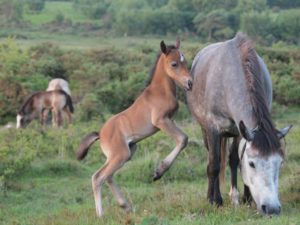
New Forest Mare & Foal
Listening to Chris Packham’s headline-seeking claims it is easy to forget how much we all depend upon commoners’ vocational commitment. To forget that ordinary people choose to continue keeping animals to graze the New Forest because they are proud and determined to preserve a grazing system that has kept the New Forest special for centuries. To forget that the rare species that survive in the New Forest, but which have been lost elsewhere, survive because of the grazing and associated land management. In the early 1990s this system came very close to collapse. We are still doing our best to keep this challenging practice alive in England’s most expensive and busiest National Park.
But the truth of commoning does not fit with Chris Packham’s prejudices:
It is untrue to claim that there are 13,000 head of livestock grazing the New Forest. He will know that the Verderers’ Marking Register is nothing more than a record of marking fees paid. A receipt for this small fee is required in order to claim CAP subsidy. To claim that every receipt represents an animal on the Forest is a travesty of the truth. This would be like claiming that everyone who takes out a gym membership was actually at the gym – all the time. Marked cattle can go straight to market. Every commoner chooses when and where to turn out animals, depending on grazing quality and the animal’s needs. It is unfortunate that the CAP works like this, particularly as the amount of funds to which the New Forest is entitled is fixed. We look forward to a day when a more sensible system can be created. Anyone who takes the time to study Natural England’s assessment of the SSSI units that make up the New Forest will quickly see that “undergrazing” is the major threat to the ecology of the New Forest. Indeed, this led to a requirement to raise cattle numbers within the current Verderers Higher Level Stewardship scheme.
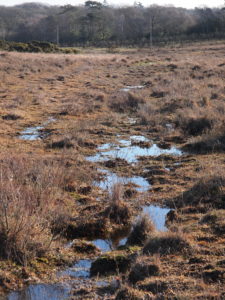
Shirley Holms Mire Restoration
It is untrue to claim that the New Forest is being “drained”.
The landscape was drained in past centuries, particularly to meet wartime agricultural needs and for the development of commercial conifer plantations. In this century we have been able to use the Higher Level Stewardship schemes to repair much of this past damage, restoring precious wetlands and streams. The drought of 2018 showed the immense value of the New Forest mires, both for the grazing animals and for rare species of global importance.
It is untrue to claim that the New Forest organisations aren’t working together Whether within the £19m Higher Level Stewardship Scheme, the £4.4m Lottery-funded Landscape Partnership, or many other brilliant initiatives, we all work closely together. Every week commoners give freely of their time to sit down with partners and plan joint working: With statutory agencies like Natural England, the New Forest Verderers, National Park Authority, and local councils, and with other voluntary groups including the National Trust, Wildlife Trusts, RSPB, Freshwater Habitats Trust, New Forest Trust, and Friends of the New Forest. For commoners this constant commitment is in addition to their day-job and animal responsibilities. It is interesting that critics of the New Forest seem to choose not to engage with these partnership projects
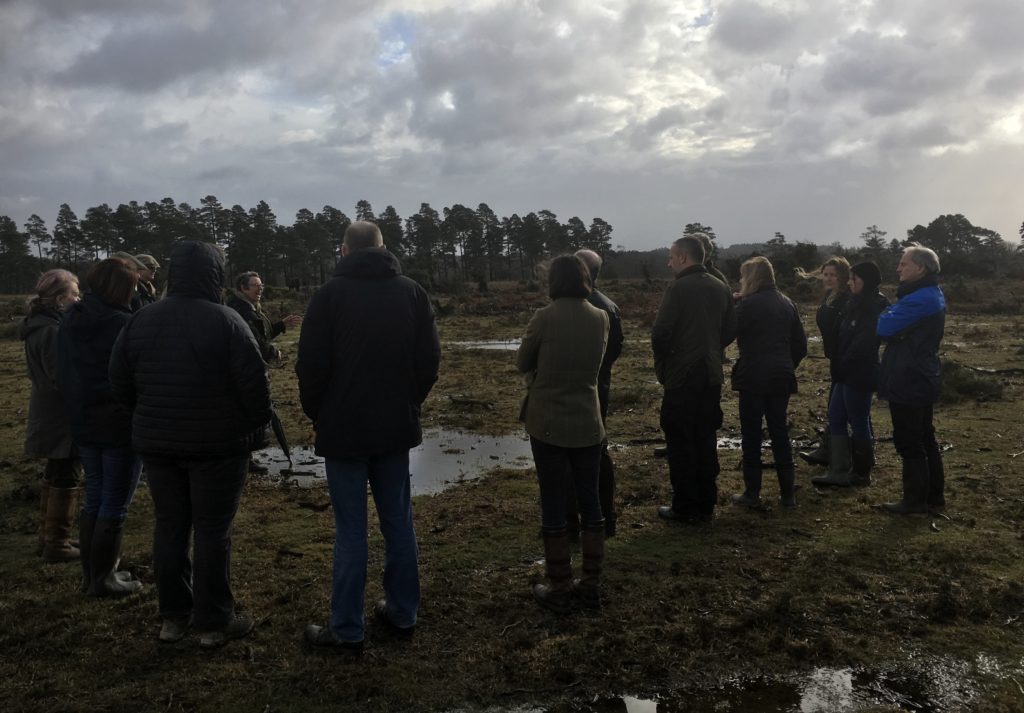
Verderers’ Welfare Tour 7th December 2018
It is untrue to claim that there are “starving” ponies on the New Forest Every year in early Spring and late Autumn the Verderers organise Welfare Tours for any organisation with an interest in the condition of commoners’ animals. DEFRA, World Horse Welfare, the RSPCA, the Donkey Sanctuary, and many other organisations and individuals choose to participate. Again the armchair critics choose not to. Any animal in poor condition will be removed from the New Forest and one of the greatest successes since the crisis of the 1990s has been the dramatic improvement in the condition and quality of commoners’ animals.
It is deeply upsetting that anyone would use their celebrity status to undermine everything that is being achieved in the New Forest, based on nothing more than personal prejudice. But commoners’ pride in the New Forest is stronger than this. Each week we celebrate new success stories, not just of achievements by Forest-run animals themselves, but also the real stories that come from our expert partners on the rare species that depend upon our continued commitment.
In the end this justified pride is much, much stronger than unjustified prejudices hurled from the sidelines.

Members Login
 Latest Tweets
Latest Tweets
Follow us
@realnewforest 4h
Icilibus sam quas aut eriatem nume corepta auta conet officaborem quodi corepta auta conet officaborem quodi apernat ectlpa dolorpiaecus.
@realnewforest 4h
Icilibus sam quas aut eriatem nume corepta auta conet officaborem quodi corepta auta conet officaborem quodi apernat ectlpa dolorpiaecus.
@realnewforest 4h
Icilibus sam quas aut eriatem nume corepta auta conet officaborem quodi corepta auta conet officaborem quodi apernat ectlpa dolorpiaecus.
With thanks for support from



Error: Contact form not found.
